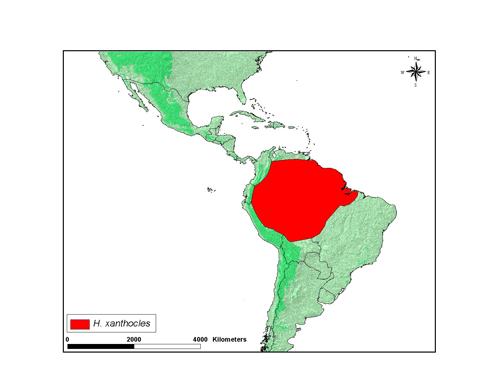Heliconius xanthocles
Margarita Beltrán and Andrew V. Z. BrowerCharacteristics
Early stages: Eggs are yellow and approximately 1.1 x 0.9 mm (h x w). Females gather together and usually each place 10 to 40 eggs on growing shoots and tendrils of the host plant. Early instar larvae have a yellow body with black bands. Mature larvae have black scoli and head, length is approximately 0.3 cm. Caterpillars are gregarious (Brown, 1981).
Adult: Heliconius xanthocles adults can be distinguished from other Heliconius species by the presence of yellow scales on the edges of the abdominal segments, giving the abdomen a ringed appearance. The wing patterns exhibit a high degree of geographical polymorphism. Several races from northern South America have entirely black hindwings, and one from southeastern Colombia (H. xanthocles explicata Brown 1976) has almost no red on either forewing or hindwing.
Geographical Distribution
Heliconius xanthocles is distributed in the Amazon basin. This map shows an approximate representation of the geographic distribution of this species. The original data used to draw these maps are derived from Brown (1979) which is available at Keith S. Brown Jr. (1979). Ecological Geography and Evolution in Neotropical Forests
Habits
H. xanthocles occurs from sea level to 1,500 m in marginal forest. Usually individuals fly rapidly and in the canopy.
Hostplant: H. xanthocles larvae feed primarily on Passiflora from the subgenus Granadilla, from Simplicifoliae, Lobatae, and Kermesinae sections. The secondary natural food plants are Quadrangulares/Digitales/Laurifoliae and Menispermifoliae/Setaceae/Pedateae/imbricatae/Incarnatae sections (Brown, 1981).
References
Bates H. W. 1862 Contributions to an insect fauna of the Amazon Valley. Lepidoptera: Heliconidae. Transactions of the Linnean Society of London 23(3): 495-566, pls. 55-56.
Brown, K. S., Jr. 1979 Ecologia Geográfica e Evolução nas Florestas Neotropicais. Campinas, São Paulo, Brasil: Universidade Estadual de Campinas.
Brown K. S. 1981 The Biology of Heliconius and Related Genera. Annual Review of Entomology 26, 427-456.
Lamas, G. 2004 Atlas of Neotropical Lepidoptera. Checklist: Part 4A Hesperioidea - Papiionoidea. Gainesville: Scientific Publishers/Association of Tropical Lepidoptera.
Title Illustrations

| Scientific Name | Heliconius xanthocles |
|---|---|
| Specimen Condition | Dead Specimen |
| View | Dorsal |
| Collection | Gerardo Lamas |
| Image Use |
 This media file is licensed under the Creative Commons Attribution-NonCommercial-ShareAlike License - Version 3.0. This media file is licensed under the Creative Commons Attribution-NonCommercial-ShareAlike License - Version 3.0.
|
| Copyright |
©

|
| Scientific Name | Heliconius xanthocles |
|---|---|
| Specimen Condition | Dead Specimen |
| View | Ventral |
| Collection | Gerardo Lamas |
| Image Use |
 This media file is licensed under the Creative Commons Attribution-NonCommercial-ShareAlike License - Version 3.0. This media file is licensed under the Creative Commons Attribution-NonCommercial-ShareAlike License - Version 3.0.
|
| Copyright |
©

|
About This Page

University of Cambridge, Cambridge, UK

Middle Tennessee State University, Murfreesboro, Tennessee, USA
Correspondence regarding this page should be directed to Margarita Beltrán at and Andrew V. Z. Brower at
Page copyright © 2010 and
 Page: Tree of Life
Heliconius xanthocles .
Authored by
Margarita Beltrán and Andrew V. Z. Brower.
The TEXT of this page is licensed under the
Creative Commons Attribution-NonCommercial-ShareAlike License - Version 3.0. Note that images and other media
featured on this page are each governed by their own license, and they may or may not be available
for reuse. Click on an image or a media link to access the media data window, which provides the
relevant licensing information. For the general terms and conditions of ToL material reuse and
redistribution, please see the Tree of Life Copyright
Policies.
Page: Tree of Life
Heliconius xanthocles .
Authored by
Margarita Beltrán and Andrew V. Z. Brower.
The TEXT of this page is licensed under the
Creative Commons Attribution-NonCommercial-ShareAlike License - Version 3.0. Note that images and other media
featured on this page are each governed by their own license, and they may or may not be available
for reuse. Click on an image or a media link to access the media data window, which provides the
relevant licensing information. For the general terms and conditions of ToL material reuse and
redistribution, please see the Tree of Life Copyright
Policies.
- First online 18 February 2007
- Content changed 13 August 2008
Citing this page:
Beltrán, Margarita and Andrew V. Z. Brower. 2008. Heliconius xanthocles . Version 13 August 2008 (under construction). http://tolweb.org/Heliconius_xanthocles/72244/2008.08.13 in The Tree of Life Web Project, http://tolweb.org/







 Go to quick links
Go to quick search
Go to navigation for this section of the ToL site
Go to detailed links for the ToL site
Go to quick links
Go to quick search
Go to navigation for this section of the ToL site
Go to detailed links for the ToL site